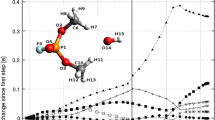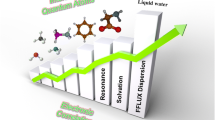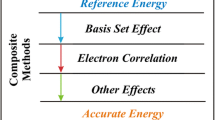Abstract
Context
An accurate description of the molecular charge density is crucial for investigating intra- and inter-molecular properties. Among the different ways of describing and analyzing it, the widely used distributed multipole analysis (DMA) is an accurate method for decomposing the molecular charge density into atom-centered electric multipoles (monopole, dipole, quadrupole, and so on) that have a direct chemical interpretation. In this work, DMA was employed to decompose the molecular charge density of six chemically distinct molecules, namely, (2R)-2-amino-3-[(S)-prop-2-enylsulfinyl] propanoic acid (AAP), 4-amine-2-nitro-1,3,5 triazole (ANTA), (RS)-Propan-2-yl methylphosphonofluoridate (SARIN), chloromethane (CLMET), and 2-aminoacetic acid (GLY) into monopole, dipole, and quadrupole values. A hypothetical variation of ANTA built by exchanging all the nitrogen atoms with phosphorus that we named 4-phosphine-2-phosphite-1,3,5-phosphorine (ANTAP) was also studied. These molecules have different chemical structures bearing distinct carbon skeletons, electronegative atoms, and electron-withdrawing/donating groups. We found that although DFT multipole values can depend considerably on the exchange–correlation functional for specific atomic sites, the associated root-mean-square errors (RMSEs) compared to benchmark MP4 mainly were about \({10}^{-5}.\) The most significant variations were for monopoles and dipoles of sites highly polarized by adjacent atoms, and to a lesser degree, for the quadrupoles. The double hybrid B2PLYP and the hybrid meta M06-2X functionals, as expected in the framework of Jacob’s ladder, overall give the most accurate results among the DFT methods. The MP2 DMA multipole values have an RMSE in relation to the MP4 benchmark mainly in the range \({10}^{-4}-{10}^{-6}\), thus representing a lower computational cost to obtain results with similar good accuracy without the ambiguity of choosing a DFT functional. The deviations of the HF multipoles from the benchmark in most cases were less than 20%, in agreement with the well-known fact that non-correlated charge densities have a slight dependence on the electronic correlation. We also confirmed that DMA values have a small dependence on the size of the basis set: deviations did not exceed 5% in most cases. However, the dependence of the DMA values on the size of the basis set increases with the rank of the electric multipole. To compute accurate values of DMA multipoles of an atom bonded to very electronegative atoms, especially dipoles and quadrupoles, a large basis set including diffuse functions is necessary. Despite that, for a given polarized basis set, the choice of the basis set to compute accurate DMA multipole values is not critical.
Methods
The molecular charge densities were computed using the electronic structure methods Hartree–Fock (HF), MP2, MP4, DFT/PBE, DFT/B3LYP, DFT/B3PW91, DFT/M06-2X, and DFT/B2PLYP implemented in the Gaussian 09 package. MP4 was the benchmark method. The DMA multipoles were obtained with the GDMA program of Stone. The 6-311G + + (d,p) basis set was used for the production calculations, and the augmented correlation-consistent Dunning’s hierarchy of basis sets was employed to evaluate the dependence of the DMA multipoles on the basis set size.









Similar content being viewed by others
Data availability
The datasets generated during and/or analyzed during the current study are reported in the additional Supporting information of this work, and are also available from the corresponding author on reasonable request.
References
Borges I, Oliveira RSS, Oliveira MAS (2022) Chapter 4—properties of molecular charge distributions affecting the sensitivity of energetic materials. In: Mathieu D (ed) Theoretical and Computational Chemistry 22 81–105 https://doi.org/10.1016/B978-0-12-822971-2.00013-9
Koch WHMC (2002) A Chemist’s Guide to Density Functional Theory, 2nd edn. Wiley-VCH, Weinheim
Cramer CJ (2004) Essentials of Computational Chemistry: Theories and Models. John Wiley & Sons, Chichester
Chopra D (2012) Advances in understanding of chemical bonding: inputs from experimental and theoretical charge density analysis. J Phys Chem A 116(40):9791–9801. https://doi.org/10.1021/jp306169f
Gatti C, Macchi P (2012) Modern Charge-Density Analysis. Springer, New York
Hathwar VR (2017) Validation of chemical bonding by charge-density descriptors: the current scenario. J Indian Inst Sci 97(2):281–298. https://doi.org/10.1007/s41745-017-0027-3
Rybakov AA, Bryukhanov IA, Larin AV (2019) Distributed atomic multipole moments for solving problems of computational chemistry. Russ J Phys Chem A 93(10):1880–1895. https://doi.org/10.1134/s0036024419100236
Stone AJ (1981) Distributed multipole analysis, or how to describe a molecular charge-distribution. Chem Phys Lett 83(2):233–239
Stone AJ, Alderton M (1985) Distributed multipole analysis—methods and applications. Mol Phys 56(5):1047–1064
Stone AJ (2000) The Theory of Intermolecular Forces. Oxford University Press, Oxford, International Series of Monographs on Chemistry
Stone AJ (2005) Distributed multipole analysis: stability for large basis sets. J Chem Theory Comput 1(6):1128–1132. https://doi.org/10.1021/ct050190+
Shi Y, Xia Z, Zhang J, Best R, Wu C, Ponder JW, Ren P (2013) Polarizable atomic multipole-based AMOEBA force field for proteins. J Chem Theory Comput 9(9):4046–4063. https://doi.org/10.1021/ct4003702
Bereau T, Andrienko D, von Lilienfeld OA (2015) Transferable atomic multipole machine learning models for small organic molecules. J Chem Theory Comput 11(7):3225–3233. https://doi.org/10.1021/acs.jctc.5b00301
Gregory JK, Clary DC, Liu K, Brown MG, Saykally RJ (1997) The water dipole moment in water clusters. Science 275(5301):814–817. https://doi.org/10.1126/science.275.5301.814
Nørby SM, Magnus Haugaard Olsen J, Kongsted J, Aagard Jensen HJ (2016) Multipole moments for embedding potentials: exploring different atomic allocation algorithms. J Comput Chem 37(20):1887–1896. https://doi.org/10.1002/jcc.24403
Conrad JA, Kim S, Gordon MS (2019) Ionic liquids from a fragmented perspective. Phys Chem Chem Phys 21(31):16878–16888. https://doi.org/10.1039/C9CP02836F
Price SL, Richards NGJ (1991) On the representation of electrostatic fields around abinitio charge-distributions. J Comput-Aided Mol Des 5(1):41–54
Mooij WTM, van Eijck BP, Price SL, Verwer P, Kroon J (1998) Crystal structure predictions for acetic acid. J Comput Chem 19(4):459–474. https://doi.org/10.1002/(SICI)1096-987X(199803)19:4%3c459::AID-JCC6%3e3.0.CO;2-R
Lommerse JPM, Price SL, Taylor R (1997) Hydrogen bonding of carbonyl, ether, and ester oxygen atoms with alkanol hydroxyl groups. J Comput Chem 18(6):757–774. https://doi.org/10.1002/(SICI)1096-987X(19970430)18:6%3c757::AID-JCC3%3e3.0.CO;2-R
Nobeli I, Price SL, Lommerse JPM, Taylor R (1997) Hydrogen bonding properties of oxygen and nitrogen acceptors in aromatic heterocycles. J Comput Chem 18(16):2060–2074. https://doi.org/10.1002/(SICI)1096-987X(199712)18:16%3c2060::AID-JCC10%3e3.0.CO;2-S
Larin AV, Vercauteren DP (1998) Approximations of the Mulliken charges for the oxygen and silicon atoms of zeolite frameworks calculated with a periodic Hartree-Fock scheme. Int J Quantum Chem 70(4–5):993–1001. https://doi.org/10.1002/(SICI)1097-461X(1998)70:4/5%3c993::AID-QUA45%3e3.0.CO;2-Y
Price SL, Stone AJ (1983) A distributed multipole analysis of charge-densities of the azabenzene molecules. Chem Phys Lett 98(5):419–423
Gamba Z, Bonadeo H (1981) Lattice dynamical calculations on azabenzene crystals: the distributed dipole model. J Chem Phys 75(10):5059–5066. https://doi.org/10.1063/1.441881
Bauer GEW, Huiszoon C (1982) Parameterization of site-site potentials in the spherical expansion formalism A point charge model for the electrostatic interaction of the aza-benzene molecules. Mol Phys 47(3):565–583. https://doi.org/10.1080/00268978200100412
Price SL (1985) A distributed multipole analysis of the charge-densities of some aromatic-hydrocarbons. Chem Phys Lett 114(4):359–364
Botelho FD, Oliveira RSS, Almeida JSFD, Franca TCC, Borges I Jr (2021) Comparação entre métodos para determinação de cargas atômicas em sistemas moleculares: a molécula n-{n-(pterina-7-il)carbonilglicil}-l-tirosina (nnpt). Quim Nova 44(2):161–171
Harrison JF (2005) Local moments from a Hirshfeld partitioning of the electron density: comparison to DMA for N2, O2 and F2. Mol Phys 103(6–7):1099–1111. https://doi.org/10.1080/00268970412331333447
Borges I (2008) Conformations and charge distributions of diazocyclopropanes. Int J Quantum Chem 108(13):2615–2622. https://doi.org/10.1002/qua.21671
Giannerini T, Borges I (2015) Molecular electronic topology and fragmentation onset via charge partition methods and nuclear fukui functions: 1,1-diamino-2,2-dinitroethylene. J Braz Chem Soc 26(5):851–859. https://doi.org/10.5935/0103-5053.20150044
Anders G, Borges I Jr (2011) Topological analysis of the molecular charge density and impact sensitivy models of energetic molecules. J Phys Chem A 115(32):9055–9068. https://doi.org/10.1021/jp204562d
Oliveira RSS, Borges Jr I (2020) Correlation between molecular charge properties and impact sensitivity of explosives: nitrobenzene derivatives. Propellants, Explosives, Pyrotechnics (at press)https://doi.org/10.1002/prep.202000233
Duarte JC, da Rocha RD, Borges I (2023) Which molecular properties determine the impact sensitivity of an explosive? A machine learning quantitative investigation of nitroaromatic explosives. Phys Chem Chem Phys 25(9):6877–6890. https://doi.org/10.1039/D2CP05339J
Oliveira MAS, Borges I (2019) On the molecular origin of the sensitivity to impact of cyclic nitramines. Int J Quantum Chem 119(8):14. https://doi.org/10.1002/qua.25868
de Oliveira RSS, Borges I (2019) Correlation between molecular charge densities and sensitivity of nitrogen-rich heterocyclic nitroazole derivative explosives. J Mol Model 25(10):314. https://doi.org/10.1007/s00894-019-4195-0
Borges I, Silva AM, Aguiar AP, Borges LEP, Santos JCA, Dias MHC (2007) Density functional theory molecular simulation of thiophene adsorption on MoS2 including microwave effects. Theochem-J Mol Struct 822(1–3):80–88
Borges I, Silva AM (2012) Probing topological electronic effects in catalysis: thiophene adsorption on NiMoS and CoMoS clusters. J Braz Chem Soc 23(10):1789–1799
Borges I, Silva AM, Modesto-Costa L (2018) Microwave effects on NiMoS and CoMoS single-sheet catalysts. J Mol Model 24(6):8. https://doi.org/10.1007/s00894-018-3662-3
Silva AM, Borges I (2011) How to find an optimum cluster size through topological site properties: Mosx model clusters. J Comput Chem 32(10):2186–2194. https://doi.org/10.1002/jcc.21802
Oliveira MAS, Oliveira RSS, Borges I (2021) Quantifying bond strengths via a Coulombic force model: application to the impact sensitivity of nitrobenzene, nitrogen-rich nitroazole, and non-aromatic nitramine molecules. J Mol Model 27(3):69. https://doi.org/10.1007/s00894-021-04669-5
Møller C, Plesset MS (1934) Note on an approximation treatment for many-electron systems. Phys Rev 46(7):618–622
Perdew JP, Burke K, Ernzerhof M (1996) Generalized gradient approximation made simple. Phys Rev Lett 77(18):3865–3868. https://doi.org/10.1103/PhysRevLett.77.3865
Becke AD (1988) Density-functional exchange-energy approximation with correct asymptotic behavior. Phys Rev A: At, Mol, Opt Phys 38:3098
Becke AD (1993) Density-functional thermochemistry. 3. The role of exact exchange. J Chem Phys 98(7):5648–5652
Zhao Y, Truhlar DG (2008) The M06 suite of density functionals for main group thermochemistry, thermochemical kinetics, noncovalent interactions, excited states, and transition elements: two new functionals and systematic testing of four M06-class functionals and 12 other functionals. Theor Chem Acc 120(1):215–241. https://doi.org/10.1007/s00214-007-0310-x
Mardirossian N, Head-Gordon M (2017) Thirty years of density functional theory in computational chemistry: an overview and extensive assessment of 200 density functionals. Mol Phys 115(19):2315–2372. https://doi.org/10.1080/00268976.2017.1333644
Grimme SWKJSL (2006) Semiempirical hybrid density functional with perturbative second-order correlation. J Chem Phys 124(3):034108. https://doi.org/10.1063/1.2148954
Schwabe T, Grimme S (2006) Towards chemical accuracy for the thermodynamics of large molecules: new hybrid density functionals including non-local correlation effects. Phys Chem Chem Phys 8(38):4398–4401. https://doi.org/10.1039/B608478H
Woon DE, Dunning TH (1995) Gaussian-basis sets for use in correlated molecular calculations. 5. Core-valence basis-sets for boron through neon. J Chem Phys 103(11):4572–4585. https://doi.org/10.1063/1.470645
Woon DE, Dunning TH (1993) Gaussian-basis sets for use in correlated molecular calculations .3. The atoms aluminum through argon. J Chem Phys 98(2):1358–1371. https://doi.org/10.1063/1.464303
Welch GWA, Karamertzanis PG, Misquitta AJ, Stone AJ, Price SL (2008) Is the induction energy important for modeling organic crystals? J Chem Theory Comput 4(3):522–532. https://doi.org/10.1021/ct700270d
Popelier PLA (2000) Atoms in molecules: an introduction. Pearson Education, Harlow
Weinhold F (2005) Comments on Purser’s Article: “Lewis Structures are Models for Predicting Molecular Structure, Not Electronic Structure.” J Chem Educ 82(4):527. https://doi.org/10.1021/ed082p527.3
Depaz JLG, Ciller J (1994) Structure and tautomerismo of Anta (aminonitrotriazole). Propellants Explos Pyrotech 19(1):32–41. https://doi.org/10.1002/prep.19940190107
Moxnes JF, Frøyland Ø, Risdal T (2017) A computational study of ANTA and NTO derivatives. J Mol Model 23 (8)https://doi.org/10.1007/s00894-017-3408-7
Kaczmarek A, Gorb L, Sadlej AJ, Leszczynski J (2004) Sarin and soman: structure and properties. Struct Chem 15(5):517–525
Black RM, Harrison JM (2009) The Chemistry of Organophosphorus Chemical Warfare Agents. In: Rappoport Z (ed) PATAI'S Chemistry of Functional Groups. John Wiley & Sons, Ltd, Chichester, UK, 70
Rocha GR, Borges I Jr, Villar JDF, Castro AT (2012) Defesa química: histórico, classificação dos agentes de guerra e ação dos neurotóxicos. Química Nova 35(10):2083–2091. https://doi.org/10.1590/S0100-40422012001000033
Calvin JA, Peng C, Rishi V, Kumar A, Valeev EF (2021) Many-body quantum chemistry on massively parallel computers. Chem Rev 121(3):1203–1231. https://doi.org/10.1021/acs.chemrev.0c00006
Cremer D (2011) Møller-Plesset perturbation theory: from small molecule methods to methods for thousands of atoms. WIREs Comput Mol Sci 1(4):509–530. https://doi.org/10.1002/wcms.58
McWeeny R, Coulson CA (1980) Coulson’s Valence. Oxford University Press, Oxford
Acknowledgements
We thank the Brazilian agencies CNPq through research grants 304148/2018-0 and 409447/2018-8, Faperj through grant E-26/201.197/2021, Capes (R.S.S.O.) for a Ph.D. scholarship and the Brazilian Army for the support of this work.
Funding
I.B. thanks From the Brazilian agencies Conselho Nacional de Desenvolvimento Científico e Tecnológico (CNPq) through research grants 304148/2018–0 and 409447/2018–8, and Fundação Carlos Chagas Filho de Amparo à Pesquisa do Estado do Rio de Janeiro (Faperj) through grant E-26/201.197/2021 for the support of this research. R.S.S.O. thanks Fundação Coordenação de Aperfeiçoamento de Pessoal de Nível Superior (Capes) for a PhD scholarship.
Author information
Authors and Affiliations
Contributions
Roberta Siqueira Soldaini Oliveira and Marco Aurélio Souza Oliveira—data curation, formal analysis, investigation, software, visualization, and writing—review and editing. Itamar Borges Junior—conceptualization, data curation, formal Analysis, funding acquisition, methodology, project administration, resources, supervision, validation, visualization, writing—original draft, and writing—review and editing.
Corresponding author
Ethics declarations
Competing interests
The authors declare no competing interests.
Additional information
Publisher's Note
Springer Nature remains neutral with regard to jurisdictional claims in published maps and institutional affiliations.
Supplementary Information
Below is the link to the electronic supplementary material.
894_2023_5758_MOESM1_ESM.docx
Supplementary file1 (DOCX 269 KB) Additional Supporting Information that includes multipoles values DMA, converged geometry data for the AAP, ANTA, ANTAP, SARIN, CLMET, and GLY molecules, and Gaussian and GDMA output and input files may be found in the online version of this article.
Rights and permissions
Springer Nature or its licensor (e.g. a society or other partner) holds exclusive rights to this article under a publishing agreement with the author(s) or other rightsholder(s); author self-archiving of the accepted manuscript version of this article is solely governed by the terms of such publishing agreement and applicable law.
About this article
Cite this article
Oliveira, R.S.S., Oliveira, M.A.S. & Borges, I. The effect of the electronic structure method and basis set on the accuracy of the electric multipoles computed with the distributed multipole analysis (DMA). J Mol Model 29, 357 (2023). https://doi.org/10.1007/s00894-023-05758-3
Received:
Accepted:
Published:
DOI: https://doi.org/10.1007/s00894-023-05758-3




